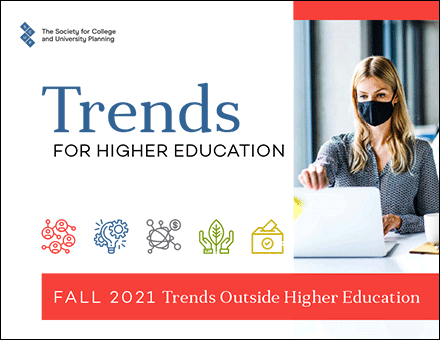- Integrated Planning
Integrated Planning
Integrated planning is a sustainable approach to planning that builds relationships, aligns the organization, and emphasizes preparedness for change.
- Topics
Topics
- Resources
Resources
Featured Formats
Popular Topics
- Events & Programs
Events & Programs
Upcoming Events
- Building Buy-in for Planning: Dealing With Resistance and Gaining Support
Online | March 11 – April 8 - Budgeting for Impact: A Working Group on Resource Planning in Higher Education
Online | Feb 5, Feb 19, March 5 - Cross-Functional Collaboration: Tools and Skills for Working Across Silos
Online | February 10, 17, 24
- Building Buy-in for Planning: Dealing With Resistance and Gaining Support
- Community
Community
The SCUP community opens a whole world of integrated planning resources, connections, and expertise.
- Integrated Planning
Integrated Planning
Integrated planning is a sustainable approach to planning that builds relationships, aligns the organization, and emphasizes preparedness for change.
- Topics
Topics
- Resources
Resources
Featured Formats
Popular Topics
- Events & Programs
Events & Programs
Upcoming Events
- Building Buy-in for Planning: Dealing With Resistance and Gaining Support
Online | March 11 – April 8 - Budgeting for Impact: A Working Group on Resource Planning in Higher Education
Online | Feb 5, Feb 19, March 5 - Cross-Functional Collaboration: Tools and Skills for Working Across Silos
Online | February 10, 17, 24
- Building Buy-in for Planning: Dealing With Resistance and Gaining Support
- Community
Community
The SCUP community opens a whole world of integrated planning resources, connections, and expertise.
 Trends for Higher Education
Trends for Higher EducationTrends Outside Higher Education | Fall 2021
 Published September 15, 2021Planning Types: Academic Planning, Campus Planning, Continuity Planning, Diversity, Equity, and Inclusion Planning, Information Technology Planning, Institutional Effectiveness Planning, Resource Planning, Strategic Enrollment Management Planning, Strategic Planning, Student Affairs Planning, Sustainability Planning
Published September 15, 2021Planning Types: Academic Planning, Campus Planning, Continuity Planning, Diversity, Equity, and Inclusion Planning, Information Technology Planning, Institutional Effectiveness Planning, Resource Planning, Strategic Enrollment Management Planning, Strategic Planning, Student Affairs Planning, Sustainability PlanningFrom the ongoing COVID–19 pandemic to the impacts of climate change, colleges and universities continue to face an environment that is volatile, uncertain, complex, and ambiguous—VUCA. Learn the key trends and movements that might become our “new normal.” This issue broadly explores trends outside of higher education.
We’ve organized Trends using STEEP:
- Social: How people think, behave, and interact, including beliefs, values, culture, and lifestyle
- Technology: How people use technology (including hardware and software), how society relies on technology, and how technology affects society
- Economic: Macro- or microeconomics, including global trends, anything related to jobs and skills needed for jobs, and industry shifts
- Environmental: Our external surroundings, including sustainability and our evolving workplaces, cities, and living spaces
- Political: Public policy, governmental systems, the people within them, and the effects of government decisions on our citizens and communities
Each trend includes a brief trend summary, a footnoted source, and discussion questions to help you analyze and act on the trend.
DOWNLOAD
Want to learn more?
- Related blog post: Under the headline, “For Whom the Pell Tolls,” an item this issue of Trends describes pending US legislation that could enable students in qualifying short-term workforce education programs to receive Pell Grants. To gain more insight into the growth of non-degree credentials, we recently spoke with Dr. Michelle Van Noy about work she has completed in the area of non-degree credentials, including development of a framework for measuring quality.
- Related webinar recording: Join Jim Downey, former vice president for planning and institutional effectiveness at Pittsburgh Theological Seminary and senior strategy consultant, and Nick Santilli, former provost at John Carroll University and SCUP’s senior director of learning strategy, as they use SCUP’s Fall 2021 Trends for Higher Education report to explore “What If?” questions in a practical format that will allow your team to pinpoint areas for institutional advancement.
- Topics
- Topics


